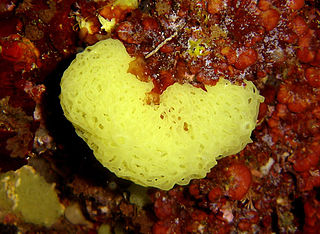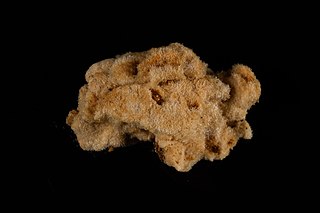
Leucosolenida is an order of sponges in the class Calcarea and the subclass Calcaronea. Species in Leucosolenida are calcareous, with a skeleton composed exclusively of free spicules without calcified non-spicular reinforcements.

Clathrina is a genus of calcareous sponge in the family Clathrinidae. Several species formerly in Clathrina were transferred to the newly erected genera Arturia, Ernstia, Borojevia, and Brattegardia in 2013. The name is derived from the Latin word "clathratus" meaning "latticed".

Minchinellidae is a family of calcareous sponges, members of the class Calcarea. It is the only family in the monotypic order Lithonida. The families Petrobionidae and Lepidoleuconidae have also sometimes been placed within Lithonida, though more recently they have been moved to the order Baerida. Thanks to their hypercalcified structure, minchinellids have a fossil record reaching as far back as the Jurassic Period.
Baerida is an order of sea sponges in the subclass of Calcaronea, first described in 2000 by Radovan Borojevic, Nicole Boury-Esnault and Jean Vacelet. Baerida contains four families; two of these families were formerly placed within the order Lithonida.

Grantia is a genus of calcareous sponges belonging to the family Grantiidae. Species of the genus Grantia contain spicules and spongin fibers.
Ascaltis pelliculata is a species of sea sponge in the family Leucascidae, first described as Leucoselenia pelliculata by Arthur Dendy in 1891. it is found in the coastal waters of Victoria.

Leuconia is a genus of calcareous sponges in the family Baeriidae. It was described by English anatomist and zoologist Robert Edmond Grant in 1833.
Leucopsila is a genus of poriferans in the family Baeriidae, was originally described as Leuconia stylifera in 1870. The genus was described by Dendy & Row in 1913.
Ascute asconoides is a species of calcareous sponge found in Australia.
Ascute uteoides is a species of calcareous sponge found in Australia.
Eilhardia is a genus of calcareous sponges in the family Baeriidae. It contains one species, Eilhardia schulzei.
Lamontia is a genus of calcareous sponges in the family Baeriidae. It consists of one species, Lamontia zona Kirk, 1895. The genus and species were described by New Zealand biologist Harry Borrer Kirk in 1895. The type locality of Lamontia zona is Cook Strait, New Zealand.
Trichogypsiidae is a family of sponges in the class Calcarea.

Soleneiscus is a genus of calcareous sponges in the family Dendyidae.
Soleneiscus radovani is a species of calcareous sponge in the family Dendyidae, and was first described in 1999 by Gert Wörheide and John Hooper. The species epithet, radovani, honours Radovan Borojevic for "his substantial and pioneering achievements in calcarean taxonomy".

Leucetta is a genus of sponges in the family Leucettidae, which was first described in 1872 by Ernst Haeckel. The type species is Leucetta primigenia Haeckel, 1872 by subsequent designation.

Leucettusa is a genus of sponges belonging to the family Leucaltidae. The species of this genus are mostly known from the Arctic and Antarctic, New Zealand and Southwest Australia.

Stellispongiida is an order of calcareous sponges, most or all of which are extinct. Stellispongiids are one of several unrelated sponge groups described as "inozoans", a name referring to sponges with a hypermineralized calcitic skeleton independent from their spicules. Stellispongiids have a solid skeleton encasing calcite spicules arranged in trabeculae. "Inozoans" and the similar "sphinctozoans" were historically grouped together in the polyphyletic order Pharetronida.








